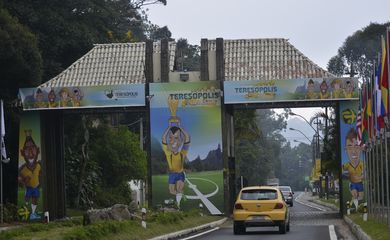A trail of destruction in Teresopólis, the official Brazil squad training center




While the city entrance is all decorated with a gateway and colorful flags, in the countryside most of the landscape is brown with the dust and the marks left by the floods which caused widespread damage and killed over 900 people in January 2011.
Brazil's national football team arrived Monday (May 26) in Teresópolis, Rio de Janeiro, where its official training center is located. However, not all about the city is World Cup excitement. In far-off neighborhoods, there is a feeling of indifference, and even discontent. While the city entrance is all decorated with a gateway and colorful flags, in the countryside most of the landscape is brown with the dust and the marks left by the floods which caused widespread damage and killed over 900 people in January 2011. People there lost everything they had, complain that they are in complete neglect, and are not a bit interested in the World Cup.

“I'm in no mood for celebration. I have lost almost all my family. I lost my wife and my daughter. Not a single brick of my house was left in place. I haven't died myself because God didn't take me. Of course we want Brazil to win though,” said stonemason Luiz Claudio Carvalho dos Santos.
“I'm in no mood for celebration. I have lost almost all my family. I lost my wife and my daughter. Not a single brick of my house was left in place. I haven't died myself because God didn't take me. Of course we want Brazil to win though,” said stonemason Luiz Claudio Carvalho dos Santos. He was cutting stone to make pavers and cobblestones just the other day in what was left of the Campo Grande neighborhood.
The area was devastated by a massive avalanche which came down from the hill and took minutes to destroy the houses, leaving dozens dead. All residents were subsequently removed from the location, and buildings were condemned and demolished. There are only a few standing ruins as evidence of the worst-ever natural disaster in Brazil's history. In some of them there still are remains of what used to be a home with a couch, a bed, kitchen furniture, personal items, and clothes, all ruined by water and time. Now, the site looks more like a ghost neighborhood with few people who resisted eviction. The local trade, once complete with supermarkets, is now down to two roadside bars. Residents still have a hard time trying to forget what they saw that night.
“Locals here are still shocked. In previous World Cups, all the place was decorated. Now there's not a sign of that, there's no excitement. I have only stayed in the local trade for the sake of the others who have also stayed. It would have been unfair of me to leave,” said Ricardo Cavalcante. He used to own three shops before the disaster, and now he gets by on a pub selling drinks, fried sausage, and some groceries for the few remaining residents of Campo Grande, whose only pleasure comes down to two pool tables.

In some of the destroyed houses there still are remains of what used to be a home with a couch, a bed, kitchen furniture, personal items, and clothes, all ruined by water and time.
Other people have even lost their jobs. Bruno Polderman, who in the days following the flood helped with the rescue efforts and evacuating the dead bodies, is having difficulty finding a job now. Because of the mud, he was infected with a bacterium that caused two deep wounds on his leg, leaving two large scars. “I can't seem to find a job as a nurse now because of the scars. My house was condemned, but they never paid any compensation,” said Bruno, who still lives in the same house: “Personally I'm in no mood for the World Cup. Things are in complete neglect here. And in the city what they really did was conceal the look and feel to please the tourists.”
The local government estimates that it will be able to deliver the first 250 homes to the displaced of 2011, and that they should make it 700 homes by December. Their goal is to deliver a total 1,600 homes by 2015. It also claims that most people impacted have received compensation or are still paid rent assistance.
Translated by Mayra Borges
Fonte: A trail of destruction in Teresopólis, the official Brazil squad training center



